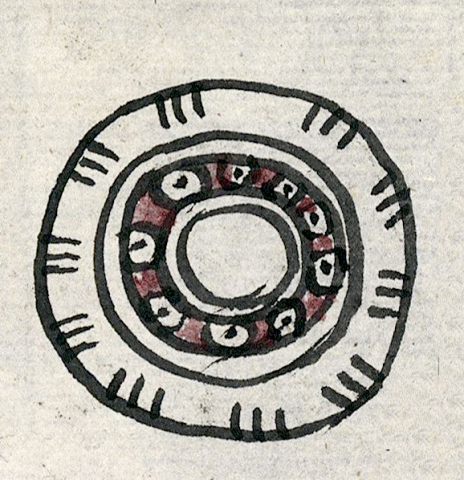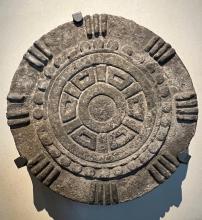tianquiztli (TetlRG)
This simplex glyph stands for tianquiztli. Paired with an image of a small church or chapel (see historical contextualizing image), it contributes to the place name Tianquizmanal(co), one of the dependent communities of the cabecera (head town) of Tetliztacan. It appears on the mapa that accompanies the c. 1580 Relación Geográfica from that community. The simplex glyph is beautifully executed with its main details outlined in black. It is made up of several concentric circles, the outer one bearing ten groups of three short black lines around its perimeter. A narrow circle edged in black follows next, succeeded by another with nine small circular shapes with black dots in their centers in a red-shaded field. Another narrow circular figure is drawn inside of this, with a final blank center to finish it off.
Robert Haskett
Compare this marketplace with others, below. Both have a ring of circles that echoes the trim just under the rooftop of a tecpan. Even one piece of agricultural land has this circular border, as does one of the finer examples of tilmatli. One has a red band, much like this one.
In Nahua culture, the word tianquiztli was also applied to a constellation, which may have been owing to some coincidence of shape between the standard marketplace and the arrangement of the stars (citlalli) that made up the constellation.
The place name Tianquizmanalco seems to be made up of the root tianquiz-, mana, which among other things “to offer, to put out,” with the locative -co, “in/at.” Thus the place name would mean “in/at the market [where] things are offered,” or of course more simply “in/at the marketplace” (a related word is tianquizmanaloyan, meaning “the act of trading in a market”). The Spanish text of the Relación relates (folio 1 recto) that this place name "quiere dezir donde se azia el mercado de los pueblos comarcanos" ("means where the market of the neighboring towns was held"). A road or path studded with human footprints beginning at the door of the church leads to the entry to the cabecera’s Franciscan church, probably indicating the subordinate status for Tianquizmanalco in terms of both religious and political matters. The small church next to the marketplace is a semantic indicator telling the viewer that Tianquizmanalco is an inhabited community, not just a tianquiztli, and serves in this way as the locative -co (see the historical contextualizing image). For more information, see Biblioteca Digital Mexicana, A.C., http://bdmx.mx/documento/mapas-relaciones-geograficas-cempoala-epazoyuca... Mundy, Barbara E., “Mapping Babel: A Sixteenth-Century Indigenous Map from Mexico,” The Appendix, 1:4 (October 2013), and the same author’s book, The Mapping of New Spain: Indigenous Cartography and the Maps of the Relaciones Geográficas (Chicago and London: The University of Chicago Press, 1996).
Robert Haskett and Stephanie Wood
tianguyz / manalco
Tianquizmanalco
Robert Haskett
c. 1580
Robert Haskett
markets, mercados, circles, círculos, nombres de lugares
Photograph by Robert Haskett, Museo Nacional de Antropología e Historia, 14 February 2023.

tianquiz(tli), market, place of commerce, https://nahuatl.wired-humanities.org/content/tianquiztli
mana, to lay down flat things; to offer, put out; https://nahuatl.wired-humanities.org/content/mana
-co, in, at, https://nahuatl.wired-humanities.org/content/co
tianquizmanaloyan, the act of trading in a marketplace or engaging in a fair, https://nahuatl.wired-humanities.org/content/tianquizmanaloyan
mercado
Robert Haskett
Relación de Tetlistaca – University of Texas Libraries Collections, 1580-11-15. https://collections.lib.utexas.edu/catalog/utblac:d6867ccb-092b-47b1-87a...).
Materials that are in the public domain (such as most of the maps in the PCL Map Collection) are not copyrighted, and no permission is needed to copy them. You may download them and use them as you wish. The image appears here courtesy of the University of Texas Libraries, The University of Texas at Austin. If you do publish anything from this database, please cite the Visual Lexicon of Aztec Hieroglyphs.






